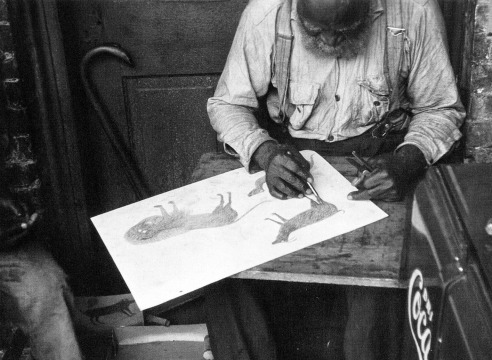
Bill Traylor
ADAA: The Art Show, Booth A11
March 2-6, 2016
Preview Gala: March 1, 2016
The works of Bill Traylor will be the focus of Betty Cuningham Gallery’s booth (A11) at the 28th annual Art Show, organized by the Art Dealers Association of America (ADAA). The Art Show opens the evening of March 1 with a gala preview to benefit the Henry Street Settlement and it remains open to the public March 2 – 6, 2016 at the Park Avenue Armory, located at Park Avenue and 67th Street in New York City.
Bill Traylor was born a slave in 1854, on the George Traylor family’s plantation in Benton, Alabama. Following Emancipation, Traylor continued to work for George Traylor and later for his son, Marion Traylor, as a farm laborer and then as a tenant farmer. In 1910, he moved to Montgomery County where he continued to farm for another 17 years. By 1928, at age 74, Bill Traylor had moved to the city of Montgomery, where he briefly worked in a shoe factory until he became crippled by arthritis. In 1936, homeless and on relief, Bill Traylor slept in the back room of a funeral parlor in downtown Montgomery.
In 1939, Charles Shannon encountered the 85-year-old Bill Traylor, seated in front of a blacksmith shop on Monroe Street in Montgomery, Alabama. He describes Traylor as having a pencil stub in hand, as if he was drawing for the first time. Intrigued, Shannon provided Traylor with art supplies, encouragement and support (purchasing many works for modest prices) until Shannon was drafted in 1942.
Fascinated by the endless inventiveness and aesthetic beauty of Bill Traylor’s work, Charles Shannon organized Traylor’s first exhibition in 1940 at New South – an arts center in Montgomery founded by Shannon and others. Shannon continued to introduce the work to several museum curators, but the actual market for Traylor’s work did not blossom until the 1970’s. Since then, Traylor’s work has been shown and collected extensively throughout the United States. His most recent exhibitions include two shows at the American Folk Art Museum in New York (2013), inclusion in the inaugural show in The Whitney Museum of American Art’s new building (2015), as well as a planned retrospective at the National Museum of American Art, Smithsonian Institution, Washington, DC, opening in 2018. Traylor’s work can be found in New York in the collections of The Metropolitan Museum of Art, the Museum of Modern Art, The Museum of American Folk Art, and The Whitney Museum of American Art, and also in the Menil Collection, Houston, TX, the Milwaukee Art Museum, Milwaukee, WI, Philadelphia Museum of Art, Philadelphia, PA and the National Museum of American Art, Smithsonian Institution, Washington, DC, among others.